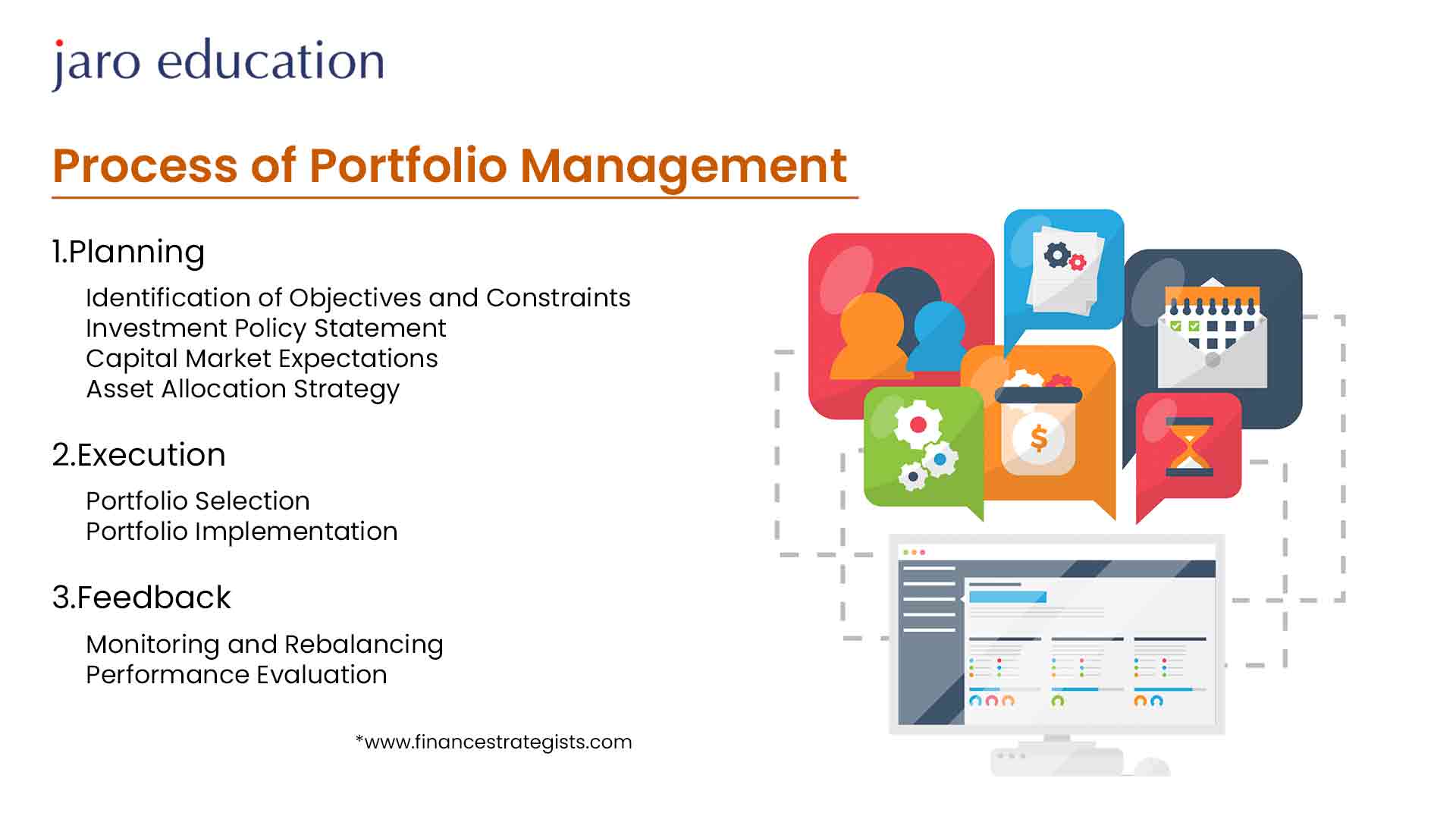
- jaro education
- 3, April 2024
- 2:00 pm
Time is money, and before investing either, every investment professional evaluates the risks and benefits of portfolio management. Nowadays, professionals are drawn to different types of investments. However, those who actively do their homework before investing know the importance of portfolio management. Financial planning isn’t just restricted to keeping track of your funds; it extends beyond that. So, before diving into the strategies of portfolio management, having an understanding of them is important.
Understanding Portfolio Management and Its Significance
Portfolio management might sound like a complex financial term to beginners. However, in its depth, it’s a strategy that any investor can use to get a better ROI.
A portfolio is a collection of different investments, such as stocks, bonds, or other assets. Each investment in your portfolio plays an integral role, much like players in a sports team. Some are stars with high potential returns but also high risk, while others provide stability but may have different growth potential.
Portfolio management involves the art and science of making decisions about:
Table of Contents
- Balancing risk against performance
- Matching investments to objectives
- Investment mix and policy
For expert investment professionals, the objectives of portfolio management are different. To them, it’s all about navigating the dynamic financial markets to maximize returns with fewer risks. For beginners, it’s an opportunity to learn the basics of investment strategy. This is how beginners start making financial decisions.

Understanding Different Types of Portfolio Management
Portfolio management involves managing assets to achieve specific investment goals. These are of different types, which include:
1. Active Portfolio Management
Some investors actively buy and sell assets to outperform the market. Active portfolio management requires thorough research and in-depth analysis. To achieve higher returns, professionals tend to make tactical investment decisions.
2. Passive Portfolio Management
Unlike active portfolio management, investors create a diversified portfolio targeting a specific market index. Passive Portfolio management requires less frequent trading and lower management fees.
3. Strategic Portfolio Management
As the name suggests, it focuses on the long-term objectives of portfolio management. The approach devised goes parallel with investments and overall financial goals. Investors need periodic reviews and adjustments based on changes in economic circumstances.
4. Tactical Portfolio Management
Investors adjust their portfolios based on short-to-medium-term market conditions. Their main aim is to capitalize on market opportunities while managing risk.
5. Dynamic Portfolio Management
Investors combine active and passive management elements, where they adjust investments according to changes in market conditions. These conditions can be economic factors that help in optimizing returns.
6. Risk Parity Portfolio Management
In risk parity management, investors distribute investments in different assets. They classify their investment to balance the risk contribution from each asset. It’s quite a different approach in contrast to the traditional one, which involves equalizing the monetary value of investments.
7. Behavioral Portfolio Management
The name of this approach defines the features of portfolio management differently. It focuses on the understanding of investor behavior and psychological factors.
8. Socially Responsible Portfolio Management
The approach in this type of management focuses on financial returns and the positive impact on society and the environment. Investors following this approach aim to follow ethical and sustainable principles.
9. Quantitative Portfolio Management
The scope of portfolio management relies on mathematical models and statistical techniques to reach investment decisions. The entire management uses algorithms to analyze market data and identify potential opportunities.
Investors may come across different portfolio management features depending on the approach type. After understanding the management types, the next move is to understand and build insights to rule the market.
Top Portfolio Management Insights and Strategies for Professionals
An intelligent portfolio is like a carefully created puzzle, with each piece playing an important role. There are different strategies you must stay aware of to achieve investment success.
1. Diversification is the Key
Diversification involves spreading investments across different assets to reduce risk. Investors can avoid the risks of poor performance in a single investment by balancing it with others that may perform better. This approach focuses on achieving a stable and consistent return in the long run. Investors can better understand the correlation between various assets through diversification.
2. Asset Allocation
Through asset allocation, investors can combine investments across different asset classes, such as stocks, bonds, and cash. It helps them manage risk by spreading exposure to various market conditions. Professionals can enhance their returns while minimizing the impact of poor-performing assets.
3. Risk Management
Risk management helps investors minimize potential losses down the road. By diversifying investments, the risks associated with specific assets can be spread out. This strategy helps protect the portfolio from adverse impacts.
4. Regular Checks Through Rebalancing
It is a critical strategy rebalancing that involves periodically adjusting the asset allocation to maintain the desired risk-return profile. Investors sell the overperforming assets and buy the underperforming ones. This ensures the portfolio that returns are optimized while managing risk over the long term.
5. Essential Market Research
In this method, investors analyze information about financial markets, investment opportunities, and economic trends. It helps them make better decisions, manage risks, and enhance their portfolios.
Market research also helps them stay aware of potential opportunities or threats. By following this approach, investors can increase their strategic approach.
6. Focusing on Investment Horizon
Investment horizon refers to the time an investor plans to hold an investment. Adopting a long-term investment horizon is considered a strong strategy in portfolio management because it allows for potential market fluctuations to even out over time.
This approach minimizes the impact of short-term market volatility, giving investments more time to grow and recover from temporary downturns. Additionally, a more extended horizon provides the opportunity to benefit from compounding returns and strategic adjustments based on the investor’s financial goals and risk tolerance.
7. Managing Liquidity
This strategy involves maintaining a balance between liquid assets and investments. This ensures the ability to meet short-term financial needs, seize investment opportunities, and navigate market fluctuations.
With sufficient Liquidity, investors can capitalize on market conditions and address unexpected expenses, enhancing overall portfolio flexibility and risk management.
8. Maintaining Tax Efficiency
Tax efficiency means optimizing investment strategies to minimize tax liabilities. Investors aim to reduce capital gains taxes and other tax obligations by strategically selecting investments and managing transactions. This can enhance overall returns, as less money is diverted to taxes, allowing for more significant wealth accumulation over time.
Effective tax planning may involve considerations such as holding investments for the long term, utilizing tax-advantaged accounts, and employing tax-loss harvesting techniques. In essence, prioritizing tax efficiency is a crucial strategy to maximize after-tax returns and preserve wealth in a portfolio.
9. Active Vs. Passive Investing
Active investing involves frequently buying and selling assets to outperform the market, relying on market analysis and forecasts. Passive investing, on the other hand, aims to replicate market performance by tracking a specific index. The debate over which strategy is better often centers on fees, as passive funds typically have lower costs.
Both approaches have pros and cons, and the choice depends on an investor’s goals, risk tolerance, and belief in their ability to beat the market consistently. Combining both strategies, a balanced approach can offer a diversified and effective portfolio management strategy.
10. Monitoring Economic Indicators
Monitoring economic indicators is crucial for portfolio management as it provides insights into the economy’s overall health. Investors can stay aware of the factors like GDP growth, inflation rates, and unemployment levels.
These indicators can signal potential market trends, helping investors adjust their portfolios to mitigate risks and capitalize on opportunities. Additionally, understanding economic conditions enables investors to anticipate changes in interest rates and inflation, guiding strategic asset allocation within their portfolios.
11. Cost Management
Cost management in portfolio management involves optimizing the allocation of resources to maximize returns while minimizing expenses. By efficiently managing costs, portfolios can enhance overall profitability and mitigate potential risks, making it an essential strategy for long-term success.
12. Investing in Dividend
Dividend investing is considered a robust portfolio management strategy for several reasons. It provides a consistent income stream through regular dividend payments, offering stability and cash flow regardless of market conditions.
Companies with a history of paying dividends often signal financial strength and stability. Reinvesting dividends can accelerate wealth growth through compounding. This approach also aligns with a long-term investment mindset, fostering a patient and disciplined approach to the market.
13. Timing of the Market
Market timing, the strategy of predicting the future movements of the financial markets, is generally considered risky and challenging. It’s not commonly viewed as one of the best strategies for portfolio management. Investors often need help to consistently time the market accurately due to its unpredictable nature.
A more widely accepted approach is to focus on a diversified, long-term investment strategy rather than attempting to time short-term market fluctuations. This approach aims to reduce risk and enhance the potential for sustainable returns over time.
14. Cyclical and Defensive Stocks
Cyclical and defensive stocks represent opposite ends of the risk spectrum. Including both in a portfolio can provide a balanced strategy. Cyclical stocks, tied to economic cycles, perform well during economic upswings, while defensive stocks, associated with stable industries like utilities, offer stability during downturns. This combination aims to capture growth opportunities and mitigate risk, enhancing overall portfolio resilience.
15. Behavioral Defensive Stocks
Behavioral defensive stocks are advantageous in portfolio management due to their resilience during market downturns. These stocks often belong to industries less sensitive to economic fluctuations, such as utilities or consumer staples.
Investors are drawn to them because they perceive that these companies provide stability and consistent returns, which aligns with behavioral biases favoring safety and risk aversion. By incorporating behavioral defensive stocks into a portfolio, investors aim to mitigate the impact of market volatility, reducing the emotional stress associated with significant market declines.
16. Behavioral Finance and Emotional Intelligence
While data and algorithms play a significant role, understanding human behavior is equally crucial in portfolio management. Behavioral finance explores how psychological factors influence financial decisions.
Professionals must recognize and manage emotions, such as fear and greed, that can impact investment choices. Students can develop emotional intelligence by studying real-world examples of behavioral biases in financial markets.
17. Technological Advancements
The advent of financial technology (Fintech) has revolutionized portfolio management. Professionals leverage sophisticated algorithms and artificial intelligence to analyze vast datasets and make data-driven investment decisions. For students, exploring the intersection of finance and technology provides a glimpse into the future landscape of portfolio management.
18. Portfolio Stress Testing
Stress testing means assessing how a portfolio would perform under adverse conditions. Investors can gauge potential risks and losses by subjecting the portfolio to various hypothetical stress scenarios, such as economic downturns or market shocks. This strategy helps identify vulnerabilities, optimize location, and enhance portfolio risk management.
19. Thematic Investing
Thematic investing strategy aims to capitalize on long-term trends, providing diversification and potential for higher returns by targeting sectors or industries expected to outperform. Integrating thematic investments in a portfolio can enhance its overall risk-return profile and align it with the investor’s strategic outlook on emerging opportunities in the market.
20. Continuous Learning
Continuous learning has an integral role for investors, reaping numerous advantages of portfolio management. It involves regularly updating and refining skills, staying informed about market trends, and adapting strategies to evolving economic conditions. This ongoing process helps portfolio managers make informed decisions, manage risks effectively, and optimize asset allocations for long-term success in dynamic financial environments.
21. Professional Help and DIY Options
Professional help in portfolio management involves:
- Hiring financial advisors or portfolio managers who possess expertise in analyzing markets.
- Managing risk.
- Making informed investment decisions.
On the other hand, DIY options refer to individuals managing their portfolios without professional assistance.
Both strategies play critical roles in portfolio management, offering diverse benefits based on individual preferences, risk tolerance, and financial knowledge. Professional help provides specialized insights and experience, while DIY options offer hands-on control and cost savings. Combining elements of both can create a balanced approach to portfolio management.
22. Interpersonal Skills are a Plus
Effective communication and interpersonal skills are crucial in portfolio management as they facilitate collaboration, understanding, and decision-making. Clear communication ensures that team members comprehend project goals, risks, and timelines, reducing the likelihood of misunderstandings. Interpersonal skills help build strong relationships, fostering teamwork and trust among stakeholders.
This collaboration is vital for effective portfolio management, where diverse teams must align on priorities, adapt to changes, and collectively navigate challenges. Communication and interpersonal skills enhance coordination, minimize conflicts, and contribute to successful portfolio outcomes.
23. Ethics and Integrity
Ethics and integrity in portfolio management involve adhering to honesty, Transparency, and accountability principles. By maintaining high ethical standards, investors and stakeholders trust the process, fostering long-term relationships and reducing the risk of fraud or misconduct.
This integrity builds a solid foundation for successful portfolio management, as it aligns with responsible decision-making and sustainable practices, ultimately contributing to a more resilient and reputable investment strategy.
24. Keeping Transparency
Transparency in portfolio management involves providing transparent and open information about a portfolio’s investments, risks, and performance. This strategy enhances trust between investors and portfolio managers, allowing for informed decision-making and risk assessment.
Mistakes Professionals Should Avoid in Portfolio Management
Transparent communication about asset allocation, fees, and market conditions helps investors understand the portfolio’s dynamics, fostering a more collaborative and informed investment relationship.

1. Lack of Diversification
One common mistake is overconcentration in a few assets or sectors. Diversification helps spread risk, reducing the impact of poor performance in a single investment.
2. Ignoring Risk Tolerance
Please align the portfolio with the investor’s risk tolerance to avoid uncomfortable situations during market fluctuations. Balancing risk and return based on individual preferences and financial goals is crucial.
3. Market Timing
Trying to predict short-term market movements often results in poor decisions. Investors should focus on a long-term strategy rather than attempting to time the market, which is notoriously challenging.
4. High Trading Frequency
Excessive trading can increase transaction costs and taxes, eroding overall returns. A well-thought-out, disciplined approach typically outperforms frequent trading.
5. Neglecting Regular Rebalancing
Portfolios should be periodically rebalanced to maintain the desired asset allocation. Ignoring this can make portfolios skewed over time, deviating from the intended risk-return profile.
6. Chasing Performance
Investors may be tempted to chase recent top-performing assets. However, past performance is not always indicative of future results. Considering a broader range of factors is crucial when making investment decisions.
7. Overlooking Fees
High fees can significantly impact overall returns. Investors should be mindful of transaction costs, management fees, and other expenses associated with their investments.
8. Failure to Continuously Monitor
Portfolio management is an ongoing process. Failing to monitor economic conditions, market trends, and changes in personal circumstances can lead to suboptimal decision-making.
9. Emotional Decision-Making
Allowing emotions like fear or greed to drive investment decisions can result in impulsive actions not aligned with long-term goals.
10. Not Having a Clear Investment Plan
A well-defined investment plan outlining goals, risk tolerance, and time horizon is essential. With a clear roadmap, investors may avoid ad-hoc decisions aligning with their financial objectives.
Conclusion
The benefits of portfolio management are countless if you follow the right and fair strategies. The insights require you to involve key findings, emphasizing the significance of diversification, risk management, and strategic decision-making in optimizing investment portfolios. It underscores the importance of staying aware of market changes and taking needful steps to achieve long-term financial goals.
These top strategies are helpful to professionals and beginners who want to stay ahead in the financial market in the long run. If you are intrigued by the investment options and take your aspirations to a height, enroll for Executive Certificate Programme in Corporate and Strategic Finance offered by IIM Mumbai and propel your career today. You can opt for this 10-month course and attend it in a live setting as well as online. You’ll also have support and guidance from expert faculties from IIM Mumbai, who are always there to assist.









